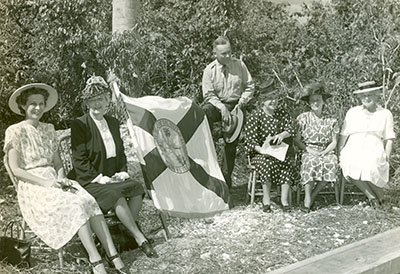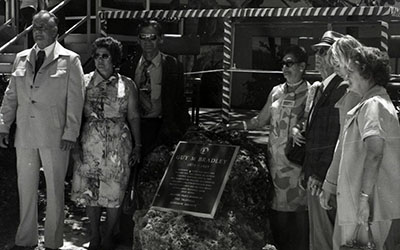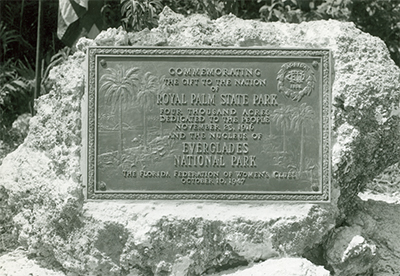
Memorials honor special people, places
Less than 24 hours had passed since graduation celebrations took place at the University of Miami in 1996, before a flight carrying five members from the UM community crashed just north of Everglades National Park and killed all on board.
Nearly two years after the crash, a memorial was established near Stanford Circle to honor the deceased members of the UM community.
| Historic photograph depicts the day the Royal Palm State Park was designated as the Everglades National Park (Photos courtesy of Everglades National Park). |  |
Among those from the UM community lost in the crash was Robert Woodus, Jr.
According to UM spokesperson Annette Gallagher, Woodus was a former UM football player who had just graduated hours earlier. Woodus, because of his death, would have a son he’d never meet. His fiancé, who stayed behind in Miami, was pregnant at the time.
“It’s important to do something,” said Patricia Whitely, vice president for student affairs in an article reported by The Miami Hurricane in 1998. “It took a while to get it all to happen and we didn’t want anymore time to pass before we memorialized their lives and acknowledge their contributions to the community.”
The memorial is located near Stanford Circle and consists of a tree and a plaque to honor the fallen.
Three years after the accident, a larger and more encompassing memorial was set up near the site of the crash. The memorial, located approximately 11.9 miles west of Krome Avenue in Miami-Dade County, points to the location of the crash site, which is actually eight miles to the north. (The memorial’s exact coordinates are at 25 degrees 45 minutes north latitude and 80 degrees 40 minutes west longitude).
The memorial itself consists of 110 pillars, representing the lives of those who died in the crash.
| Members of the Everglades National Park gather near the Flamingo Visitor Center on the date the plaque commemorating Guy Bradley was installed. |  |
Many news sites, such as CNN.com and the Sun Sentinel, have incorrectly reported that the site was located within national park parameters.
“The ValuJet memorial is actually not inside Everglades National Park,” said Nancy Russell, Everglades National Park museum curator, in an e-mail. “The park’s boundary runs to the south of Tamiami Trail and the memorial is to the north of the road. I believe it is on the state water management district’s water conservation area land.”
According to Russell, national park officials do not honor victims within park premises.
“We (the National Park Service) tend not to place memorials inside parks, unless of course, the unit itself is a memorial (e.g., Oklahoma City, Flight 93, the various memorials on the Mall in (Washington,) D.C., etc.), the memorial is a historic marker (e.g., something placed before the unit became a national park or in the early days of the parks, or cemetery markers) or a unit that is designated a memorial to commemorate an event (e.g., De Soto National Memorial commemorates De Soto even though we now know he never actually landed there),” she said.
Still, the National Park Service does have some plaques to honor certain people or places.
“Everglades does have some plaques which commemorate certain people/things such as Guy Bradley, Royal Palm State Park, prestige plaques (e.g. World Heritage site designation, International biosphere reserve designation, etc.) …” Russell said in an email.
Other Markers
Guy Bradley is remembered at the Everglades National Park for his work at the site before the park was even established.
Bradley, who served as one of the country’s first game wardens and also served as a deputy sheriff for Monroe County, was shot and killed while enforcing a ban on bird hunting. The American Ornithologists’ Union hired Bradley at the Florida Audubon Society’s request.
According to Russell, there are two different plaques to commemorate his work protecting the area’s birds.
She explained that Hurricane Donna washed the original plaque that marked his grave away in 1960. The Florida Audubon Society originally placed it.
“It became a part of the museum collection, which is on exhibit in Flamingo [visitor center] that commemorates him,” Russell said.
In addition to the original plaque that used to mark Bradley’s grave, there is a larger plaque outside the same visitor center that commemorates him.
Visitor Emily Smith, 16, was visiting the Flamingo Visitor Center with her grandparents. The plaque inside caught her eye.
“I think it’s really cool that this man died protecting birds in an area that would later become a national park,” she said.
The Royal Palm State plaque is similar to the Guy Bradley plaque.
According to Russell, prior to the establishment of the Everglades National Park, a portion of the park was set aside as a state park, called the Royal Palm State Park.
 |
Royal Palm State Park plaque – designating the the area that was set aside after the Florida Federation of Women’s Club’s Preservation Committee chairwoman May Mann Jennings campaigned for the designation of Paradise Key as a state park. The area was then donated to form the Everglades National Park. |
“The Florida Federation of Women’s Club was getting the area of the park known as Paradise Key or Royal Palm, set aside,” Russell said. “The local chapter had influential people in the women’s club, so they were able to get the state to set aside this area so that it didn’t get developed and make it a state park.”
According to the National Park Service website, the area was set aside after the Florida Federation of Women’s Club’s Preservation Committee chairwoman May Mann Jennings campaigned for the designation of Paradise Key as a state park.
In 1916, the state set aside 960 acres for Royal Palm State Park. Henry Flagler’s wife matched the state’s acreage donation, doubling the total amount of space in the park. According to the website, at the same time, Ingraham highway, a road that ran from Florida City to Paradise Key, had been completed and was dedicated with the Royal Palm State Park on Nov. 23, 1916. By 1921, 2,080 additional acres were donated by the state, making Royal Palm State park a grand 4,000-acre state park.
“Everglades National Park was designated in 1934, but it wasn’t actually established until 1947, and once the park was established, sort of the core of the park and land acquisition was the donation of the Royal Palm State Park,” Russell said.
The plaque, located at the Royal Palm State’s viewing area, indicates that the donation serves as the “nucleus” of the space that is currently the Everglades National Park.
Other markers or plaques at the park include the World Heritage site designation and the International biosphere reserve designation.
Russell discussed the importance of those markers.
“Some of the other park plaques we have in the park commemorate some of the Everglades’ national and international significance,” she said. “At the [Ernest F.] Coe Visitor Center, there are plaques for the fact that the Everglades National Park is a World Heritage site. It’s a significant designation … the same thing with the International biosphere reserve. Those help put the park not just into a national ecological context, but also in an international heritage context.”
If You Go
Memorial for ValuJet Flight Victims
- Date installed: May 11, 1999
- Purpose: Honor the victims aboard Flight 592. The flight departed Miami International Airport on May 11, 1996 and crashed near the Everglades National Park, due to a fire located in the cargo compartment.
- Directions to memorial: The memorial, located approximately 11.9 miles west of Krome Avenue in Miami-Dade County, points to the location of the crash site, which is actually eight miles to the north. (The memorial’s exact coordinates are at 25 degrees 45 minutes north latitude and 80 degrees 40 minutes west longitude).
- Note: This memorial is not located within the Everglades National Park.
Guy Bradley Plaques
- Date Installed: The grave marker washed away during Hurricane Donna in 1960, but was recovered and placed within the Flamingo Visitor Center. Both plaques’ exact installation dates are unknown.
- Purpose: The plaque and grave marker are meant to honor Guy Bradley’s memory, who was shot while protecting bird species as a game warden. The plaque reads “Audubon warden was shot and killed of this shore by outlaw feather hunters, July 1905. His martyrdom created nationwide indignation, strengthened bird protection laws, and helped bring Everglades National Park into being.”
- Directions: The plaques are located inside and outside the Flamingo Visitor Center. The Flamingo Visitor Center is located at 40001 State Highway 9336, Homestead, Fla., 33034. For more information, call 305-242-7700.
Royal Palm State Park Plaque
- Date Installed: October 10, 1947
- Purpose: To honor the original Royal Palm State Park’s conservation efforts. All the land from the previously known Royal Palm State Park was donated to form the “nucleus” of what is currently known as the Everglades National Park.
- Directions: The Royal Palm State Park dedication plaque is located at the original Royal Palm State Park viewing area, or approximately 4 miles west of Ernest F. Coe Visitor Center on Route 9336, Everglades National Park, Fla. The Ernest F. Coe Visitor Center is located at 40001 State Road 9336, Homestead, Fla., 33034.
- For more information on the Ernest F. Coe Visitor Center, visit http://www.nps.gov/ever/planyourvisit/coedirections.htm or call 305-242-7700.
World Heritage Site Designation and International Biosphere Reserve Designation
- Purpose: The Everglades National Park was declared a national park on Dec. 6, 1947 under the May 1934 Act of Congress. The park was later accepted as a biosphere reserve in 1976 and added to the World Heritage List in 1979.
- Directions: The plaques are located at the Ernest F. Coe Visitor Center, which is located at 40001 State Road 9336, Homestead, Fla., 33034.
- For more information on the Ernest F. Coe Visitor Center, visit http://www.nps.gov/ever/planyourvisit/coedirections.htm or call 305-242-7700.

Comments are Closed